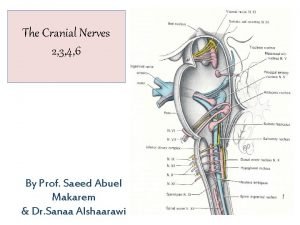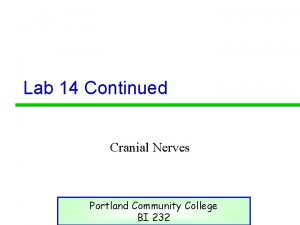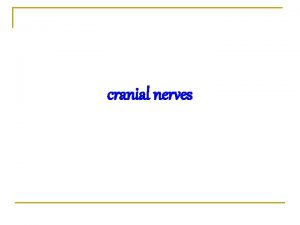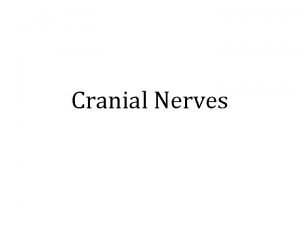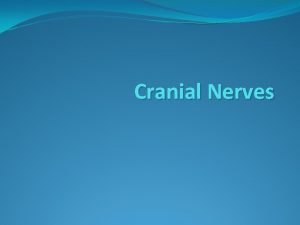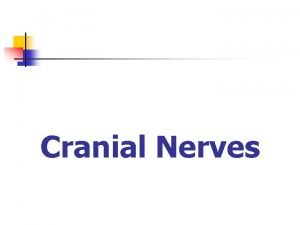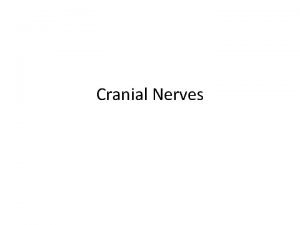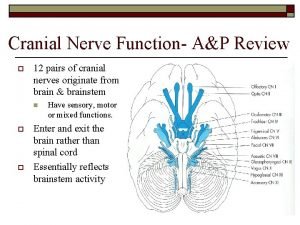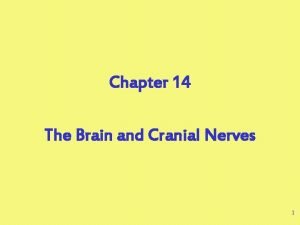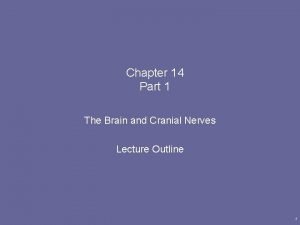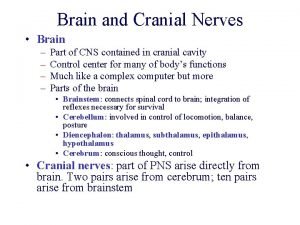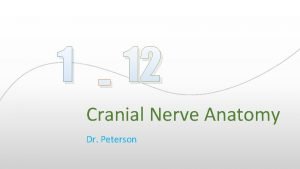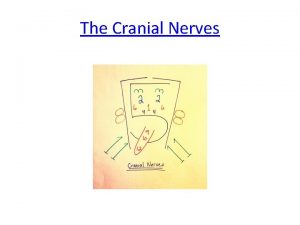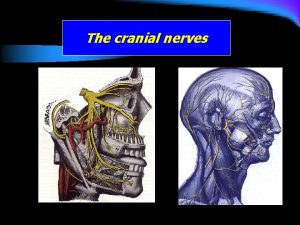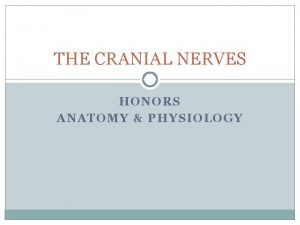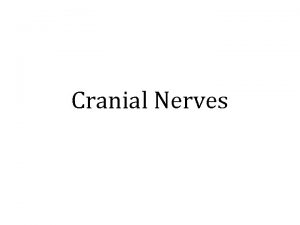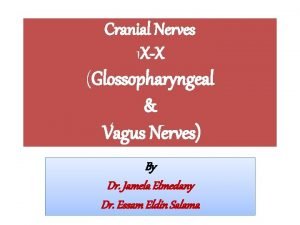Chapter 13 Review of The Cranial Nerves Cranial














- Slides: 14

Chapter 13 Review of The Cranial Nerves

Cranial Nerve I: Olfactory • Passes through the cribriform plate of the ethmoid bone • Fibers run through the olfactory bulb and terminate in the primary olfactory cortex • Functions solely by carrying afferent impulses for the sense of smell

Cranial Nerve II: Optic • Arises from the retina of the eye • Optic nerves pass through the optic canals and converge at the optic chiasm • They continue to the thalamus where they synapse • From there, the optic radiation fibers run to the visual cortex • Functions solely by carrying afferent impulses for vision

Cranial Nerve III: Oculomotor • Fibers extend from the ventral midbrain, pass through the superior orbital fissure, and go to the extrinsic eye muscles • Functions in raising the eyelid, directing the eyeball, constricting the iris, and controlling lens shape • Parasympathetic cell bodies are in the ciliary ganglia

Cranial Nerve IV: Trochlear • Fibers emerge from the dorsal midbrain and enter the orbits via the superior orbital fissures; innervate the superior oblique muscle • Primarily a motor nerve that directs the eyeball

Cranial Nerve V: Trigeminal • Composed of three divisions: ophthalmic (V 1), maxillary (V 2), and mandibular (V 3) • Fibers run from the face to the pons via the superior orbital fissure (V 1), the foramen rotundum (V 2), and the foramen ovale (V 3) • Conveys sensory impulses from various areas of the face (V 1) and (V 2), and supplies motor fibers (V 3) for mastication

Cranial Nerve VI: Abdcuens • Fibers leave the inferior pons and enter the orbit via the superior orbital fissure • Primarily a motor nerve innervating the lateral rectus muscle

Cranial Nerve VII: Facial • Fibers leave the pons, travel through the internal acoustic meatus, and emerge through the stylomastoid foramen to the lateral aspect of the face • Mixed nerve with five major branches • Motor functions include facial expression, and the transmittal of autonomic impulses to lacrimal and salivary glands • Sensory function is taste from the anterior two-thirds of the tongue

Cranial Nerve VIII: Vestibulocochlear • Fibers arise from the hearing and equilibrium apparatus of the inner ear, pass through the internal acoustic meatus, and enter the brainstem at the pons-medulla border • Two divisions – cochlear (hearing) and vestibular (balance) • Functions are solely sensory – equilibrium and hearing

Cranial Nerve IX: Glossopharyngeal • Fibers emerge from the medulla, leave the skull via the jugular foramen, and run to the throat • Nerve IX is a mixed nerve with motor and sensory functions • Motor – innervates part of the tongue and pharynx, and provides motor fibers to the parotid salivary gland • Sensory – fibers conduct taste and general sensory impulses from the tongue and pharynx

Cranial Nerve X: Vagus • The only cranial nerve that extends beyond the head and neck • Fibers emerge from the medulla via the jugular foramen • The vagus is a mixed nerve • Most motor fibers are parasympathetic fibers to the heart, lungs, and visceral organs • Its sensory function is in taste

Cranial Nerve XI: Accessory • Formed from a cranial root emerging from the medulla and a spinal root arising from the superior region of the spinal cord • The spinal root passes upward into the cranium via the foramen magnum • The accessory nerve leaves the cranium via the jugular foramen • Primarily a motor nerve § § Supplies fibers to the larynx, pharynx, and soft palate Innervates the trapezius and sternocleidomastoid, which move the head and neck

Cranial Nerve XII: Hypoglossal • Fibers arise from the medulla and exit the skull via the hypoglossal canal • Innervates both extrinsic and intrinsic muscles of the tongue, which contribute to swallowing and speech

The End
 Cranial nerves 2 3 4 6
Cranial nerves 2 3 4 6 Cranial nerves mnemonic
Cranial nerves mnemonic How to assess glossopharyngeal nerve
How to assess glossopharyngeal nerve Optic nerve names
Optic nerve names Labeling cranial nerves
Labeling cranial nerves Cranial nerves
Cranial nerves Cranial nerve acronym
Cranial nerve acronym Cranial nerves
Cranial nerves Cranial nerves classification
Cranial nerves classification Cranial nerve for smile
Cranial nerve for smile Cranial nerves labeled with roman numerals
Cranial nerves labeled with roman numerals Figure 14-2 cranial nerves labeled
Figure 14-2 cranial nerves labeled Crossed extensor reflex
Crossed extensor reflex Cranial nerve xi
Cranial nerve xi First and second cranial nerves
First and second cranial nerves
